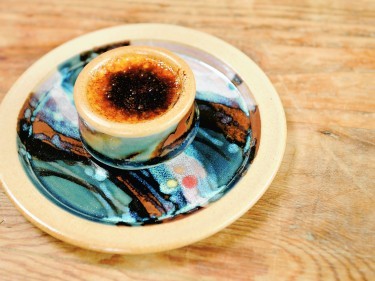Award-winning executive chef Michael Smith, of the Three Chimneys in Skye, creates some delicious autumnal dishes
There’s no better time of year to try venison. The dish I’ve created today is a good one for introducing children to venison. It’s made using ingredients that the deer themselves would eat – juniper, chanterelles and blaeberries, which all grow wild.
Make friends with your local butcher and treat yourself to a nice piece of tasty yet low-fat vension. If you don’t like this meat, the recipe can also be used with cuts of pork, lamb or chicken, while the oatmeal can be replaced with regular breadcrumbs.
For dessert, I’ve selected creme brulee, which some say originates in Aberdeen – I like to think that’s true. You don’t need a bain-marie to make the custard, just a good pot on the stove. However, I’d recommend using a chef’s blowtorch to get the topping right. You can pick these
up for about £10 from supermarkets and using this makes all the difference. It’s also a lot easier than trying to create the crunchy topping with the heat from the grill.
I’ve served this in a pretty dish made by Edinbane Pottery in Skye. It’s so beautiful, you really don’t need to add any extra decoration to the dessert.
BREADED VENISON COLLOPS WITH JUNIPER CABBAGE, CHANTERELLES AND BLAEBERRIES
SERVES 4
Loin of venison, trimmed (pork, chicken or beef fillet can be used)
300g seasonal greens, finely shredded (kale, savoy cabbage)
4 rashers streaky bacon, cut into thin strips
200g chanterelles
100g blaeberries
2 large shallots, peeled, halved and thinly sliced lengthways
1 small carrot (cut as the shallot)
1 clove garlic, crushed or finally grated
2 juniper berries, crushed in pestle and mortar
1 tsp Arran mustard (optional)
100ml double cream (optional)
Fine breadcrumbs/medium oatmeal/flour/whisked egg
Slice the venison into “collops”, or rough discs, about 3/4 of an inch thick.
Dust the collops in the flour, then egg and finally the breadcrumbs.
Dip once more in the egg, then crumb and put to one side.
Heat a large frying pan and add a little oil.
Once the oil is hot, fry half the collops on one side until golden brown, turning the heat down to medium if needed.
Turn the collops and repeat. These can be kept in a warm oven while the remaining half and the cabbage are cooked.
To cook the collops medium or more, leave in a preheated oven at 190C for 3-4 minutes before serving.
The cabbage is cooked almost like a stir fry. In a wide and shallow pan, heat a small amount of rapeseed oil until just smoking.
Add the sliced shallots and fry for 1 minute, stirring all the time. Now add the bacon and fry for another 2 minutes, stirring.
Next, add the carrot, garlic and juniper.
Fry for 1-2 minutes until the carrot is just tender.
Finally, add the cabbage and mustard, along with a little water from a freshly boiled kettle to help the cabbage steam a little.
Cook the cabbage for 2-3 minutes.
For a touch of decadence, some double cream can be added at this stage.
Quickly bring the cream to a boil to thicken it slightly and serve the cabbage on a warm plate, placing the cooked collops on top.
SERVES 4
1 pint double cream
6 egg yolks
45g castor sugar
1 vanilla pod, split lengthways, seeds scraped
Add the vanilla pod and seeds to the cream in a pan and slowly bring to a simmer. Whisk the yolks and sugar together thoroughly until as thick and pale as possible.
Pour the hot cream on to the yolk mix, whisking all the time to incorporate completely.
Once combined, return this mix to a clean pan and begin to reheat the custard until just before it boils.
The best way to do this is use a digital probe. If so, bring the custard to 86C. This will ensure yolks are cooked and the custard will set.
Pour the custard through a sieve and into a jug.
Allow to cool for 5 minutes and then decant into ramekins or similar. Set in the fridge for 24 hours (overnight).
To serve, cover the top of each ramekin with castor sugar and tap off the excess.
Now glaze until a dark caramel, ideally with a small blowtorch or under a very hot grill.

